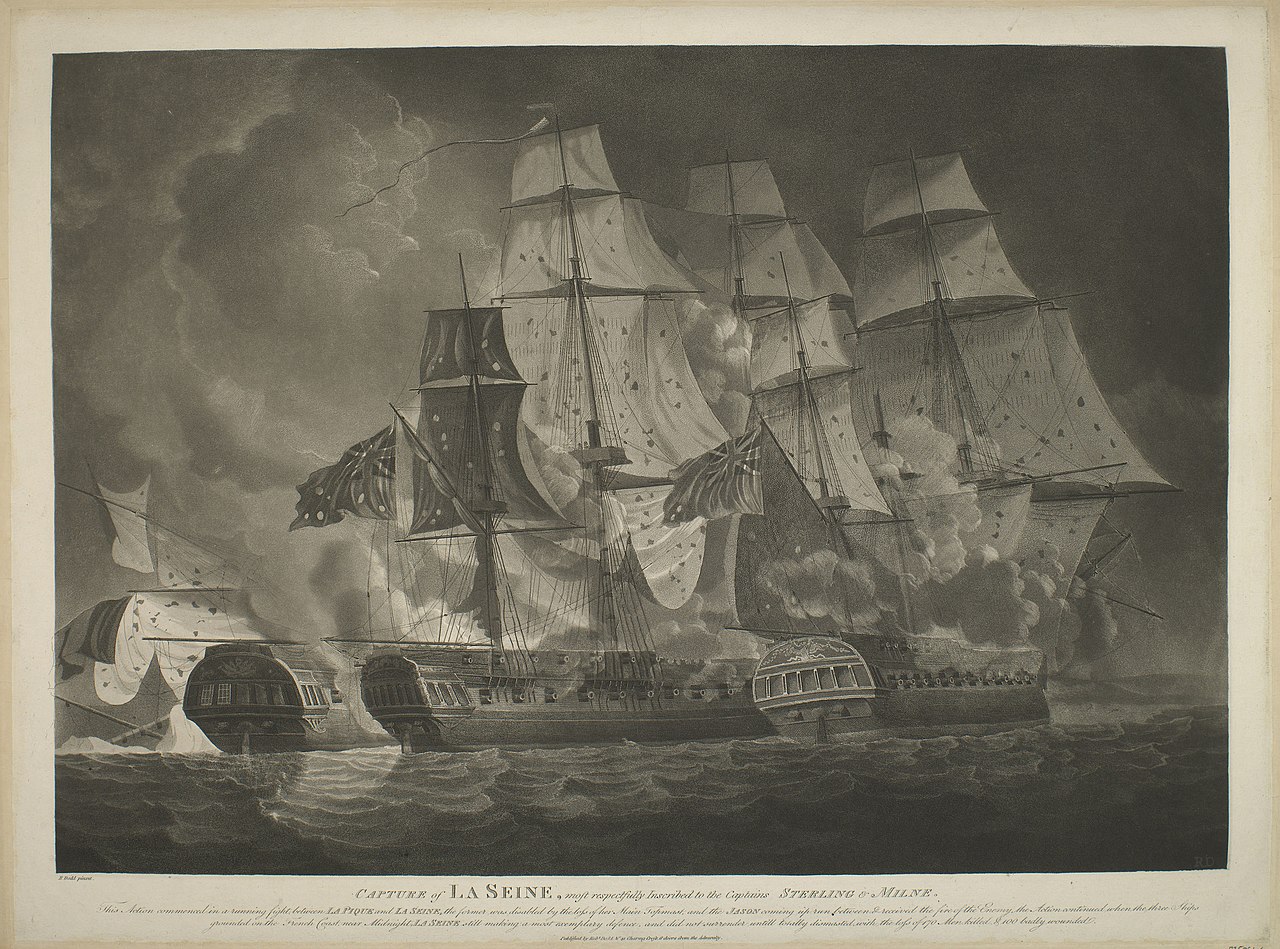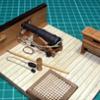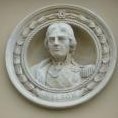-
Posts
2,245 -
Joined
-
Last visited
Reputation Activity
-
 Beef Wellington reacted to robdurant in HMS Ethalion 1797 by robdurant - FINISHED - Caldercraft - 1:64 - Modified from HMS Diana 1794 kit
Beef Wellington reacted to robdurant in HMS Ethalion 1797 by robdurant - FINISHED - Caldercraft - 1:64 - Modified from HMS Diana 1794 kit
I've finished the starboard gallery now. I decided to mimic the decoration from the builder's model on the Greenwich collection here using painted paper... this meant I could design and print out the pattern and then cut it out, paint it, and stick it to the model because it _should_ form to the upper part of the gallery... At the moment the pva has made it rather glossy, but I'm hopeful that a coat of matt varnish will flatten it and make it look more in place with the rest of the gallery decoration. The "verticals" were added between the windows adding an extra element of depth, and the decorations added as per the stern. The close-up's brutal, but it looks rather nicer in person...
I've also started attaching the deck furniture and adding the cross beams. (I still need to remember to add the cleats! MUST NOT FORGET!)...
Yesterday evening I scratch built a couple of elm-tree pumps... The support for the handle supplied for the kit is the same width as the 1:24 diagram - that wouldn't do, so I used some spare photo-etch (chains from HM Schooner Pickle) to fashion a more fitting support for the handle. The pump links are Pickle photo-etch eyelets. Here they are with some of the kit parts in front of them...
And in place... (the chain pumps are still waiting to be finished off an attached.)
In the meantime my daughter and I have been doing some card modelling
Not bad for a ten year old!
Happy building
Rob
-
 Beef Wellington reacted to Blue Ensign in HM Cutter Cheerful 1806 by Blue Ensign - FINISHED - Syren Ship Model Company - 1:48 scale
Beef Wellington reacted to Blue Ensign in HM Cutter Cheerful 1806 by Blue Ensign - FINISHED - Syren Ship Model Company - 1:48 scale
Post 69
Completing the Chainplates
I now get back to fettlin' the Chainplates and with the deadeye strops completed I can now gauge the width of the chainplate fold over to secure them.
A further 'on model' trial fit of the Chainplates to check positions and form the bends required where the Chain fits over the wale.
6078
This is a bit of a scary exercise and is done with the model supported on towels and a flat metal edge used to press the chains into shape.
This needs to be done before blackening for obvious reasons.
6080
The chains are then blackened;
washed in soapy water, rinsed, dipped in acid, rinsed again, submerged in the brass black. and once again rinsed.
I also tested a deadeye in the blackening fluid to test the effect on the Boxwood. There was no visible effect on either the colour or the stability.
This is just as well as once the chainplate has been messed about fitting and adjusting the connecting loop, a further dip in the brass black is required.
This is one of the downsides to metal blacking items such as this rather than painting them, but for me the finish is far preferable.
All this is a fiddly exercise, particularly getting the deadeyes to sit reasonably level with each other. Tiny differences in the strop and chainplate loops contrive to work against you, to produce an uneven top line.
6129(2)
In relation to the fixing of the chainplates I have followed the Admiralty plan and placed the second bolt above the wale, also shown on Chuck's plan, rather than have the two fixings thro' the wale.
It took a days work to complete one side of the Chainplates, with still a little more adjusting and touching in to do.
Backstay plates
I am using Caldercraft 5mm brass etched hooks for the rigging attachment to the Backstay plates so the plate loops need to be made to accept these.
6133
6119
Much quicker to make and fit the backstay plates.
Overall three days work to complete and fit the ironwork.
6125
6120
6128
6131
I can now leave the Blacksmiths Forge and return to the Carpentry shop.
B.E.
15/02/2019
-
 Beef Wellington reacted to CDW in Harbor Tug by CDW - FINISHED - Revell - Box Scale - PLASTIC
Beef Wellington reacted to CDW in Harbor Tug by CDW - FINISHED - Revell - Box Scale - PLASTIC
The hull red and black hull colors do not lend well to a defined water line. So I thought it might look better if I created a thin white later line.
To do so, I cut a thin strip of white decal paper to a width that looks suitable and apply it along the waterline. The decal paper is ink jet waterslide paper sold by a company that's now defunct, Bel Decals. I was sad to learn they went tango uniform, but fortunately for me, I bought white and clear decal paper in bulk packs of 25 each, 8 1/2" x 11" sheets, before they went the way of the Dodo Bird.
-
 Beef Wellington got a reaction from Timmo in HMS Jason by Beef Wellington - Caldercraft - 1:64 - Artois-class frigate modified from HMS Diana 1794
Beef Wellington got a reaction from Timmo in HMS Jason by Beef Wellington - Caldercraft - 1:64 - Artois-class frigate modified from HMS Diana 1794
Thanks everyone for the very kind words and likes....we've reached another "phone a friend" moment to assist with my indecision:
Hauling Tackle rethink:
A previously described, looking to assemble hauling tackles off the ship. Initially planned to use 0.3mm Syren line for the block stropping and 0.2mm for the tackle fall to get a little size contrast. While initially happy with the result, after making some of these up and staring at them I can't help but feel the 0.2mm is undersized. A tackle was made up with 0.3mm line to experiment, this is a little harder to work with the frapping but think a suitably repeatable processes is possible after experimentation. Once made, they are very easy to hook into place, and seem to sit nicely even without dilute PVA.
So, which size do you think looks most appropriate? While still a little undecided, I'm now leaning toward the 0.3mm, and suspect 0.25mm (if available) would be spot on!
After rigging the tackles and mounted in the serving machine, the frapping then becomes more manageable. The final turn is simply fed through the previous turn and is held in place by friction quite securely.
The comparisons: The 0.2mm tackle fall below:
The comparisons: The 0.3mm tackle fall below (the line has not been trimmed yet)
And side by side (0.3mm on the left, 0.2mm on the right)
-
 Beef Wellington reacted to MrBlueJacket in Red Jacket by MrBlueJacket - FINISHED - BlueJacket Shipcrafters - Scale 1/8" = 1' (1:96)
Beef Wellington reacted to MrBlueJacket in Red Jacket by MrBlueJacket - FINISHED - BlueJacket Shipcrafters - Scale 1/8" = 1' (1:96)
So over the w/e I sprayed the hull bottom.
-
 Beef Wellington reacted to SimonV in Mercury by SimonV - Amati/Victory Models - Scale 1:64 - 99% scratchbuild
Beef Wellington reacted to SimonV in Mercury by SimonV - Amati/Victory Models - Scale 1:64 - 99% scratchbuild
Deck is finished.
For surface finishing I choose Shellac instead oil, because I really like warmer tone and also try to implement different finishes and techniques into model. 4 layers of shellac was used.
Difference to kit deck is obvious (last photo) .
-
 Beef Wellington got a reaction from Canute in Newsworthy updates from Chris Watton
Beef Wellington got a reaction from Canute in Newsworthy updates from Chris Watton
Chris - did you consider a similar approach to that which Chuck is taking on his Winchelsea project...the carved results are just amazing.
-
 Beef Wellington got a reaction from hollowneck in Newsworthy updates from Chris Watton
Beef Wellington got a reaction from hollowneck in Newsworthy updates from Chris Watton
Chris - did you consider a similar approach to that which Chuck is taking on his Winchelsea project...the carved results are just amazing.
-
 Beef Wellington got a reaction from mtaylor in Newsworthy updates from Chris Watton
Beef Wellington got a reaction from mtaylor in Newsworthy updates from Chris Watton
Chris - did you consider a similar approach to that which Chuck is taking on his Winchelsea project...the carved results are just amazing.
-
 Beef Wellington reacted to chris watton in Newsworthy updates from Chris Watton
Beef Wellington reacted to chris watton in Newsworthy updates from Chris Watton
It has been a while, but I have been busy.
I have almost completed the hull assembly for my version of Alert, I am now waiting for the castings to come back to me (cannon barrels, small winch drum, anchors etc.). I have made quite a few changes to the designs whilst building this.
Apart from the deadeyes, all the fittings are bespoke, which means that for once, the drum winch doesn't look out of place (or out of period..). The belaying pins are quite small on this model (following Goodwin's AotS book Alert, so I did those in PE. I have tried to make it as detailed as I can, while still being quite easy to fit together.
Am glad I chose Tanganika wood for the second planking (although would love cherry), as it gives the hull a 'warmer' look. I wanted to use this wood for the prototype of Pegasus, as I knew it would suite the overall look of the model much better, but unfortunately, someone else started the hull on that one..
Was apprehensive about putting these pics on here, as it's my first model I have done outside an external company, to eventually put on the market, and it's quite scary (buy also a little exciting..)
-
 Beef Wellington got a reaction from JpR62 in HMS Jason by Beef Wellington - Caldercraft - 1:64 - Artois-class frigate modified from HMS Diana 1794
Beef Wellington got a reaction from JpR62 in HMS Jason by Beef Wellington - Caldercraft - 1:64 - Artois-class frigate modified from HMS Diana 1794
Thanks all for the speedy replies. Going to go down the 0.3mm route. After making the post I realized that it was the time already invested that was giving me pause. After hearing your opinions, the demons have been purged.
Pat - The cap squares are the PE parts provided in the kit, they seem to work quite well. These were rather fiddly to introduce the curvature, and I wasn't able to quite get the hard angle it ideally should because of the thickness. but think they are passable at viewing distance.
-
 Beef Wellington got a reaction from BANYAN in HMS Jason by Beef Wellington - Caldercraft - 1:64 - Artois-class frigate modified from HMS Diana 1794
Beef Wellington got a reaction from BANYAN in HMS Jason by Beef Wellington - Caldercraft - 1:64 - Artois-class frigate modified from HMS Diana 1794
Thanks all for the speedy replies. Going to go down the 0.3mm route. After making the post I realized that it was the time already invested that was giving me pause. After hearing your opinions, the demons have been purged.
Pat - The cap squares are the PE parts provided in the kit, they seem to work quite well. These were rather fiddly to introduce the curvature, and I wasn't able to quite get the hard angle it ideally should because of the thickness. but think they are passable at viewing distance.
-
 Beef Wellington got a reaction from Shipyard sid in HMS Jason by Beef Wellington - Caldercraft - 1:64 - Artois-class frigate modified from HMS Diana 1794
Beef Wellington got a reaction from Shipyard sid in HMS Jason by Beef Wellington - Caldercraft - 1:64 - Artois-class frigate modified from HMS Diana 1794
Thanks everyone for the very kind words and likes....we've reached another "phone a friend" moment to assist with my indecision:
Hauling Tackle rethink:
A previously described, looking to assemble hauling tackles off the ship. Initially planned to use 0.3mm Syren line for the block stropping and 0.2mm for the tackle fall to get a little size contrast. While initially happy with the result, after making some of these up and staring at them I can't help but feel the 0.2mm is undersized. A tackle was made up with 0.3mm line to experiment, this is a little harder to work with the frapping but think a suitably repeatable processes is possible after experimentation. Once made, they are very easy to hook into place, and seem to sit nicely even without dilute PVA.
So, which size do you think looks most appropriate? While still a little undecided, I'm now leaning toward the 0.3mm, and suspect 0.25mm (if available) would be spot on!
After rigging the tackles and mounted in the serving machine, the frapping then becomes more manageable. The final turn is simply fed through the previous turn and is held in place by friction quite securely.
The comparisons: The 0.2mm tackle fall below:
The comparisons: The 0.3mm tackle fall below (the line has not been trimmed yet)
And side by side (0.3mm on the left, 0.2mm on the right)
-
 Beef Wellington got a reaction from Kevin in HMS Jason by Beef Wellington - Caldercraft - 1:64 - Artois-class frigate modified from HMS Diana 1794
Beef Wellington got a reaction from Kevin in HMS Jason by Beef Wellington - Caldercraft - 1:64 - Artois-class frigate modified from HMS Diana 1794
Thanks everyone for continued interest, kind comments.and likes...
Block Stropping:
I've started stropping blocks for the hauling tackles. I'm opting for a double-single block combination, although I've read that doubles were only used on 32lb'ers. What I think this really means is that the tackle consisted of 2 double blocks. For a mid-range 18lb'er, a double-single seems appropriate and makes engineering sense.
This seems yet another painfully slow repetitive process! With this progressing in the background, will be intersperse with other sundry items. Whilst not too difficult once the approach has been proven, clumsiness never quite seems to diminish. Overall, happy with the way these turned out which is really testament to the fantastic blocks that Syren produces. The picture below is the result of 3 solid evenings work....sufficient for the waist guns.
Hooks were threaded with 0.3mm Syren line, and secured using 4 alternating overhand loops using tan Uni-thread (barely visible given its so close in color, but is what was also used for the breech rope seizing). For the 1/8" double block, the strop was twisted through 90 degrees while securing to ensure the appropriate alignment with the block. GS-Hypo was applied and left to dry before trimming off excess Uni-thread Line held in position around the block and then secured with a simple overhand loop Dilute PVA applied to the overhand loop and the stropping around the block. Was very liberal with this as it is not visible when dry, and anything that provides additional security seems silly to ignore. Trim excess stropping line once PVA has dried
Waist Beams:
First off, a correction needed to be made to the interior bulkhead to correct the position of the beam at the front of the main mast. The position of these had been taken literally from the plans very early in the build and it was clear that they are not in the appropriate position relative to the mainmast.
Secondly, needed to finally decide how to deal with the supplied walnut beams. These have a pretty rough grain and require a lot of cleanup to get nice smooth curves after removing from the sheet. Following the scheme shown on the contemporary models (painted red with upper natural face of boxwood), thin strips of overwide boxwood strips were liberally glued to the top of the beam, gradually sanded back and painted when flush. The lamination is virtually undetectable, and it also helps ensure the walnut grain is minimised. Filler can be used in any stubborn imperfections. Although a bit of a cheat, I just couldn't face cutting my own from box, and quite honestly, I doubt I could get satisfactory results with tools at my disposal.
Sub-Deck alterations:
Increasing the thickness of the beams also has the benefit that the top of the beams are flush with the sub-deck. Hoping this means that the gang boards can now be planked with the sub-deck providing a solid base, but remaining invisible from normal viewing angles. Slots were cut into the sub-deck to accommodate the laminated top surface. Picture hopefully self explanatory.
In position, the next required adjustment is revealed. The waist opening in the sub-deck has perfectly parallel sides. After studying various deck plans, it appears more appropriate for the gangboards to follow the line of hull (i.e. planks are constant width throughout their length). The approximate width of the gang boards were estimated from the AOTS plans and transferred to the deck. The hashed area indicates what will need to be remove. In actuality, more will be removed to set it back from the actual edge of the planking proper.
Back to stropping more blocks....
-
 Beef Wellington got a reaction from KARAVOKIRIS in HMS Jason by Beef Wellington - Caldercraft - 1:64 - Artois-class frigate modified from HMS Diana 1794
Beef Wellington got a reaction from KARAVOKIRIS in HMS Jason by Beef Wellington - Caldercraft - 1:64 - Artois-class frigate modified from HMS Diana 1794
Thanks everyone for the very kind words and likes....we've reached another "phone a friend" moment to assist with my indecision:
Hauling Tackle rethink:
A previously described, looking to assemble hauling tackles off the ship. Initially planned to use 0.3mm Syren line for the block stropping and 0.2mm for the tackle fall to get a little size contrast. While initially happy with the result, after making some of these up and staring at them I can't help but feel the 0.2mm is undersized. A tackle was made up with 0.3mm line to experiment, this is a little harder to work with the frapping but think a suitably repeatable processes is possible after experimentation. Once made, they are very easy to hook into place, and seem to sit nicely even without dilute PVA.
So, which size do you think looks most appropriate? While still a little undecided, I'm now leaning toward the 0.3mm, and suspect 0.25mm (if available) would be spot on!
After rigging the tackles and mounted in the serving machine, the frapping then becomes more manageable. The final turn is simply fed through the previous turn and is held in place by friction quite securely.
The comparisons: The 0.2mm tackle fall below:
The comparisons: The 0.3mm tackle fall below (the line has not been trimmed yet)
And side by side (0.3mm on the left, 0.2mm on the right)
-
 Beef Wellington reacted to Gahm in HMS Jason by Beef Wellington - Caldercraft - 1:64 - Artois-class frigate modified from HMS Diana 1794
Beef Wellington reacted to Gahm in HMS Jason by Beef Wellington - Caldercraft - 1:64 - Artois-class frigate modified from HMS Diana 1794
I would go for the 0.3 tackle. Fantastic work, Jason!
Thomas
-
 Beef Wellington reacted to rafine in HMS Jason by Beef Wellington - Caldercraft - 1:64 - Artois-class frigate modified from HMS Diana 1794
Beef Wellington reacted to rafine in HMS Jason by Beef Wellington - Caldercraft - 1:64 - Artois-class frigate modified from HMS Diana 1794
Beautifully done Jason.
Bob
-
 Beef Wellington reacted to BANYAN in HMS Jason by Beef Wellington - Caldercraft - 1:64 - Artois-class frigate modified from HMS Diana 1794
Beef Wellington reacted to BANYAN in HMS Jason by Beef Wellington - Caldercraft - 1:64 - Artois-class frigate modified from HMS Diana 1794
Very nice work Jason, I prefer the 0.3mm as well.
Just noticed how nice the trunnion capping pieces are on the carriages. Did you make these? If not where did you get them?
cheers
Pat
-
 Beef Wellington got a reaction from egkb in HMS Jason by Beef Wellington - Caldercraft - 1:64 - Artois-class frigate modified from HMS Diana 1794
Beef Wellington got a reaction from egkb in HMS Jason by Beef Wellington - Caldercraft - 1:64 - Artois-class frigate modified from HMS Diana 1794
Thanks everyone for the very kind words and likes....we've reached another "phone a friend" moment to assist with my indecision:
Hauling Tackle rethink:
A previously described, looking to assemble hauling tackles off the ship. Initially planned to use 0.3mm Syren line for the block stropping and 0.2mm for the tackle fall to get a little size contrast. While initially happy with the result, after making some of these up and staring at them I can't help but feel the 0.2mm is undersized. A tackle was made up with 0.3mm line to experiment, this is a little harder to work with the frapping but think a suitably repeatable processes is possible after experimentation. Once made, they are very easy to hook into place, and seem to sit nicely even without dilute PVA.
So, which size do you think looks most appropriate? While still a little undecided, I'm now leaning toward the 0.3mm, and suspect 0.25mm (if available) would be spot on!
After rigging the tackles and mounted in the serving machine, the frapping then becomes more manageable. The final turn is simply fed through the previous turn and is held in place by friction quite securely.
The comparisons: The 0.2mm tackle fall below:
The comparisons: The 0.3mm tackle fall below (the line has not been trimmed yet)
And side by side (0.3mm on the left, 0.2mm on the right)
-
 Beef Wellington got a reaction from Dfell in HMS Jason by Beef Wellington - Caldercraft - 1:64 - Artois-class frigate modified from HMS Diana 1794
Beef Wellington got a reaction from Dfell in HMS Jason by Beef Wellington - Caldercraft - 1:64 - Artois-class frigate modified from HMS Diana 1794
Thanks everyone for the very kind words and likes....we've reached another "phone a friend" moment to assist with my indecision:
Hauling Tackle rethink:
A previously described, looking to assemble hauling tackles off the ship. Initially planned to use 0.3mm Syren line for the block stropping and 0.2mm for the tackle fall to get a little size contrast. While initially happy with the result, after making some of these up and staring at them I can't help but feel the 0.2mm is undersized. A tackle was made up with 0.3mm line to experiment, this is a little harder to work with the frapping but think a suitably repeatable processes is possible after experimentation. Once made, they are very easy to hook into place, and seem to sit nicely even without dilute PVA.
So, which size do you think looks most appropriate? While still a little undecided, I'm now leaning toward the 0.3mm, and suspect 0.25mm (if available) would be spot on!
After rigging the tackles and mounted in the serving machine, the frapping then becomes more manageable. The final turn is simply fed through the previous turn and is held in place by friction quite securely.
The comparisons: The 0.2mm tackle fall below:
The comparisons: The 0.3mm tackle fall below (the line has not been trimmed yet)
And side by side (0.3mm on the left, 0.2mm on the right)
-
 Beef Wellington got a reaction from JesseLee in HMS Jason by Beef Wellington - Caldercraft - 1:64 - Artois-class frigate modified from HMS Diana 1794
Beef Wellington got a reaction from JesseLee in HMS Jason by Beef Wellington - Caldercraft - 1:64 - Artois-class frigate modified from HMS Diana 1794
Thanks everyone for the very kind words and likes....we've reached another "phone a friend" moment to assist with my indecision:
Hauling Tackle rethink:
A previously described, looking to assemble hauling tackles off the ship. Initially planned to use 0.3mm Syren line for the block stropping and 0.2mm for the tackle fall to get a little size contrast. While initially happy with the result, after making some of these up and staring at them I can't help but feel the 0.2mm is undersized. A tackle was made up with 0.3mm line to experiment, this is a little harder to work with the frapping but think a suitably repeatable processes is possible after experimentation. Once made, they are very easy to hook into place, and seem to sit nicely even without dilute PVA.
So, which size do you think looks most appropriate? While still a little undecided, I'm now leaning toward the 0.3mm, and suspect 0.25mm (if available) would be spot on!
After rigging the tackles and mounted in the serving machine, the frapping then becomes more manageable. The final turn is simply fed through the previous turn and is held in place by friction quite securely.
The comparisons: The 0.2mm tackle fall below:
The comparisons: The 0.3mm tackle fall below (the line has not been trimmed yet)
And side by side (0.3mm on the left, 0.2mm on the right)
-
 Beef Wellington got a reaction from realworkingsailor in HMS Jason by Beef Wellington - Caldercraft - 1:64 - Artois-class frigate modified from HMS Diana 1794
Beef Wellington got a reaction from realworkingsailor in HMS Jason by Beef Wellington - Caldercraft - 1:64 - Artois-class frigate modified from HMS Diana 1794
Thanks everyone for the very kind words and likes....we've reached another "phone a friend" moment to assist with my indecision:
Hauling Tackle rethink:
A previously described, looking to assemble hauling tackles off the ship. Initially planned to use 0.3mm Syren line for the block stropping and 0.2mm for the tackle fall to get a little size contrast. While initially happy with the result, after making some of these up and staring at them I can't help but feel the 0.2mm is undersized. A tackle was made up with 0.3mm line to experiment, this is a little harder to work with the frapping but think a suitably repeatable processes is possible after experimentation. Once made, they are very easy to hook into place, and seem to sit nicely even without dilute PVA.
So, which size do you think looks most appropriate? While still a little undecided, I'm now leaning toward the 0.3mm, and suspect 0.25mm (if available) would be spot on!
After rigging the tackles and mounted in the serving machine, the frapping then becomes more manageable. The final turn is simply fed through the previous turn and is held in place by friction quite securely.
The comparisons: The 0.2mm tackle fall below:
The comparisons: The 0.3mm tackle fall below (the line has not been trimmed yet)
And side by side (0.3mm on the left, 0.2mm on the right)
-
 Beef Wellington got a reaction from Gregory in HMS Jason by Beef Wellington - Caldercraft - 1:64 - Artois-class frigate modified from HMS Diana 1794
Beef Wellington got a reaction from Gregory in HMS Jason by Beef Wellington - Caldercraft - 1:64 - Artois-class frigate modified from HMS Diana 1794
Thanks everyone for the very kind words and likes....we've reached another "phone a friend" moment to assist with my indecision:
Hauling Tackle rethink:
A previously described, looking to assemble hauling tackles off the ship. Initially planned to use 0.3mm Syren line for the block stropping and 0.2mm for the tackle fall to get a little size contrast. While initially happy with the result, after making some of these up and staring at them I can't help but feel the 0.2mm is undersized. A tackle was made up with 0.3mm line to experiment, this is a little harder to work with the frapping but think a suitably repeatable processes is possible after experimentation. Once made, they are very easy to hook into place, and seem to sit nicely even without dilute PVA.
So, which size do you think looks most appropriate? While still a little undecided, I'm now leaning toward the 0.3mm, and suspect 0.25mm (if available) would be spot on!
After rigging the tackles and mounted in the serving machine, the frapping then becomes more manageable. The final turn is simply fed through the previous turn and is held in place by friction quite securely.
The comparisons: The 0.2mm tackle fall below:
The comparisons: The 0.3mm tackle fall below (the line has not been trimmed yet)
And side by side (0.3mm on the left, 0.2mm on the right)
-
 Beef Wellington got a reaction from davyboy in HMS Jason by Beef Wellington - Caldercraft - 1:64 - Artois-class frigate modified from HMS Diana 1794
Beef Wellington got a reaction from davyboy in HMS Jason by Beef Wellington - Caldercraft - 1:64 - Artois-class frigate modified from HMS Diana 1794
Thanks everyone for continued interest, kind comments.and likes...
Block Stropping:
I've started stropping blocks for the hauling tackles. I'm opting for a double-single block combination, although I've read that doubles were only used on 32lb'ers. What I think this really means is that the tackle consisted of 2 double blocks. For a mid-range 18lb'er, a double-single seems appropriate and makes engineering sense.
This seems yet another painfully slow repetitive process! With this progressing in the background, will be intersperse with other sundry items. Whilst not too difficult once the approach has been proven, clumsiness never quite seems to diminish. Overall, happy with the way these turned out which is really testament to the fantastic blocks that Syren produces. The picture below is the result of 3 solid evenings work....sufficient for the waist guns.
Hooks were threaded with 0.3mm Syren line, and secured using 4 alternating overhand loops using tan Uni-thread (barely visible given its so close in color, but is what was also used for the breech rope seizing). For the 1/8" double block, the strop was twisted through 90 degrees while securing to ensure the appropriate alignment with the block. GS-Hypo was applied and left to dry before trimming off excess Uni-thread Line held in position around the block and then secured with a simple overhand loop Dilute PVA applied to the overhand loop and the stropping around the block. Was very liberal with this as it is not visible when dry, and anything that provides additional security seems silly to ignore. Trim excess stropping line once PVA has dried
Waist Beams:
First off, a correction needed to be made to the interior bulkhead to correct the position of the beam at the front of the main mast. The position of these had been taken literally from the plans very early in the build and it was clear that they are not in the appropriate position relative to the mainmast.
Secondly, needed to finally decide how to deal with the supplied walnut beams. These have a pretty rough grain and require a lot of cleanup to get nice smooth curves after removing from the sheet. Following the scheme shown on the contemporary models (painted red with upper natural face of boxwood), thin strips of overwide boxwood strips were liberally glued to the top of the beam, gradually sanded back and painted when flush. The lamination is virtually undetectable, and it also helps ensure the walnut grain is minimised. Filler can be used in any stubborn imperfections. Although a bit of a cheat, I just couldn't face cutting my own from box, and quite honestly, I doubt I could get satisfactory results with tools at my disposal.
Sub-Deck alterations:
Increasing the thickness of the beams also has the benefit that the top of the beams are flush with the sub-deck. Hoping this means that the gang boards can now be planked with the sub-deck providing a solid base, but remaining invisible from normal viewing angles. Slots were cut into the sub-deck to accommodate the laminated top surface. Picture hopefully self explanatory.
In position, the next required adjustment is revealed. The waist opening in the sub-deck has perfectly parallel sides. After studying various deck plans, it appears more appropriate for the gangboards to follow the line of hull (i.e. planks are constant width throughout their length). The approximate width of the gang boards were estimated from the AOTS plans and transferred to the deck. The hashed area indicates what will need to be remove. In actuality, more will be removed to set it back from the actual edge of the planking proper.
Back to stropping more blocks....
-
 Beef Wellington got a reaction from Mirabell61 in HMS Jason by Beef Wellington - Caldercraft - 1:64 - Artois-class frigate modified from HMS Diana 1794
Beef Wellington got a reaction from Mirabell61 in HMS Jason by Beef Wellington - Caldercraft - 1:64 - Artois-class frigate modified from HMS Diana 1794
OC, Carl, Rob, Thomas, Mike, Dave, Pat and all the likes...definitely helps keeping one moving forward!
Finally, have all the guns in position an the breeching ropes in place. Amazingly time consuming, no more need be said, and glad its behind me. I did allow myself the small concession of using a ringbolt for the less visible guns, and went with a ringbolt and ring for those visible in the waist area. Despite the latter being more 'correct', the jury is still out on whether the results totally warrant it at this scale as the eyebolts only version seems acceptable to my eye (comparison photo below). As usual, dilute PVA was used to help keep the breech ropes in position and to try give them a sense of weight. Photos seem to call attention to all the little dings and dents that seem unavoidable and thankfully not really noticeable during normal viewing.
A very simple jig was used to help keep lengths consistent. When using rings, I found that opening up a ringbolt using a small metal point and reclosing was easier, faster and predictable than opening up the ring itself.





.jpg.d84ec4dad1d7791e855dca06210ab6f3.thumb.jpg.f45209242e851d4409eca1a09293165b.jpg)








